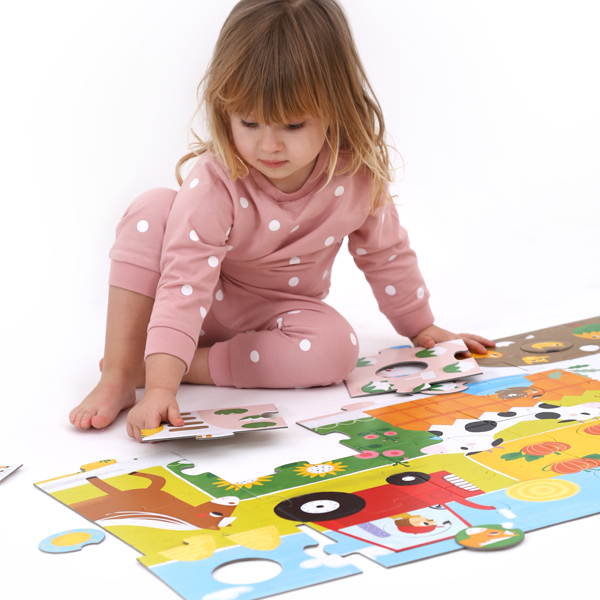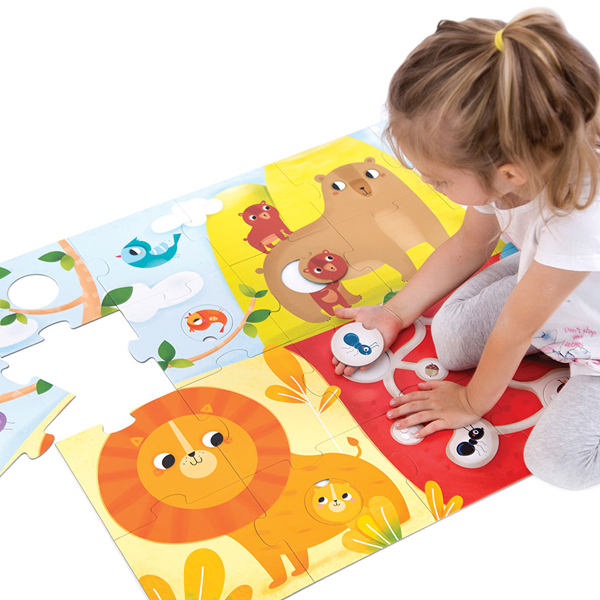Fun with fine motor skills
What are motor skills? This broad term refers to general mobility and any activity that requires physical movement. Large motor skills are related to the movement of the body in space: standing, walking, running, bending down, etc. Fine motor skills are related to grasping and manipulating objects. In other words, it refers to the dexterity of hands and fingers.
Development of fine and large motor skills in children
Remember that:
- Children develop in a comprehensive manner, i.e. various skills and abilities are being honed at the same time: motor, cognitive, emotional, social.
- The stages of development in a given area follow a specific sequence, and acquiring new skills is the basis for learning new ones in the future. For example, in order to run, a toddler must first learn to stand and walk.
- You can support your child’s natural development with age-appropriate games. This is extremely good news: learning through play is both the most enjoyable and effective way to grow!
Toys for training fine motor skills
How can you support the development of fine motor skills in a 2-year-old? Have fun as much as possible and practice your daily activities: grab various objects, learn to eat with a fork and spoon, brush your teeth and groom yourself, squeeze toys, make your first drawing attempts (a toddler may still hold a crayon with the entire hand and use sweeping movements!), build sandcastles, cook together (assigning your toddler safe tasks adapted to their age), arrange blocks, assemble puzzles, rearrange pieces…
Encourage your child to engage in various activities and be patient! Remember that perfecting new skills takes a long time, but practice really does make perfect. Take into account that your toddler may not always complete a task and there may be moments of frustration. That’s completely natural! Be present for your child during these moments, helping them to cope with setbacks and the emotions that arise in relation to them.
With older children, continue your favorite games and introduce new, increasingly difficult variations that require greater precision. Make clay figures and objects, draw and paint, including with your fingers and chalk, play with beads – artistic games are perfect developmental activities. During drawing and the first attempts to write, make sure that your child has the correct posture and holds the crayon or pencil correctly. Make sure their elbow is on the table and the workstation is well lit. Good habits will pay off in the future! The older your child is, the easier it is to put together more complex puzzles with smaller pieces.
Toys that improve motor coordination
- We offer kids toys that match their age and skills. What does that mean? Playing with them should not be too difficult or discouraging. The right toy also shouldn’t be too easy or it will become boring. Finally, it is not only the form, quality and safety of a toy that count, but also the subject matter.
- Puzzles improve fine motor skills and hand-eye coordination – it is not only the hand, but also the eyes and how the eyes control the performance of tasks that counts. What’s more, playing with puzzles is also excellent exercise for large motor skills – you can lay them on the floor, walk between them and bend down, and pretend to be the animals, vehicles or other objects presented in the pictures. This is an inexhaustible source of games for comprehensive development!
- Grip develops gradually – very young children must learn to manipulate objects with precision. That is why Banana Panda puzzles are large and durable to make them easier for little hands to hold. We also understand that puzzle matching (a trivial task for adults!) is a skill that simply takes practice. For example, the mix-and-match circles loved by children in our collection, are elements that younger children often grab with their whole hands and “tap” with their hands – this gives them time to learn precise movements in an exceptionally pleasant way.
Puzzles for two-year-olds that foster fine motor skills
Puzzles always make great gifts for two-year-olds. For example, check out the Suuuper Size Puzzle Farm Match Fun by Banana Panda, a large floor puzzle (24 pieces) with 10 interchangeable circles. Check out these adorable farm animals. Toddlers love them! The illustrations are colorful and encourage children to combine traditional puzzles and insert the circles, learn new words, make funny noises… For kids, it’s a great way to spend time, especially when a parent joins in the fun. At the same time, it is an excellent exercise for fine motor skills, perceptiveness and imagination.
What makes jigsaw puzzles so worthwhile?
Spatial imagination, logical thinking, patience, new words – playing with puzzles brings all of these benefits. But … assembling them can be a challenge! Toddlers not only need to connect the pieces that fit together physically. The meaning behind the puzzles also matters. In Suuuper Size Puzzle Farm Match Fun, all the circles can be freely rearranged, which is a great way to test whether your toddler knows what he sees, recognizes certain animals, understands the task to be completed … and if your child is in the mood for silly fun, he or she might insert, for example, a horse in the space where the tractor driver ought to be!
Sounds like a recipe for great fun, right? It is, although at the same time these are games that improve the efficiency and precision of hands and fingers. This is also excellent preparation for learning to write in the future, although at the moment that may seem far off. The development of fine motor skills does not take place in isolation, so mix it up with sports and movement games, games on the floor, reading together and similar activities – outdoors in the summer – and you have the makings of a beautiful day.




















